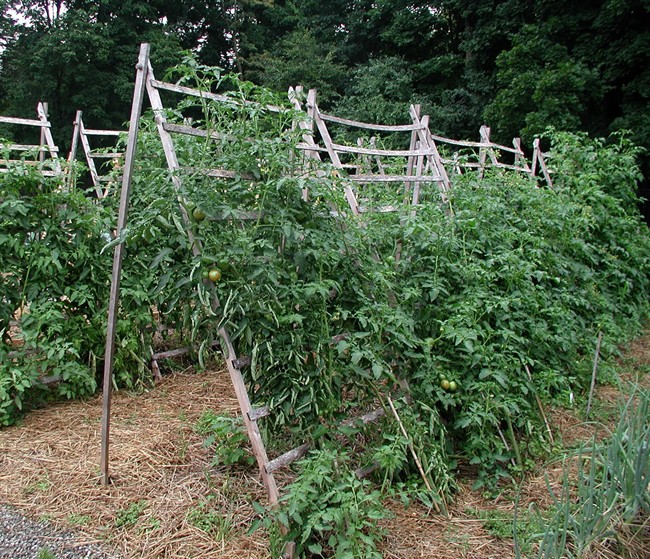
Just grow up! Proper use of stakes can keep many tall garden plants healthy
“Grow up.” That’s what I tell some of my plants.
Upright plants, bathed in air, are less apt to get fungal diseases, and those bearing fruits — tomatoes, for example — are less likely to have their fruits attacked by slugs and turtles.
And of course, flowers that stand tall stare boldly from the garden.
Some plants cry out to be staked, while others are more ambivalent. Delphiniums, lilies and larkspurs grow upright all bythemselves, but can be buffeted down by wind or rain unless staked. Not so a vine of tomato or trumpet honeysuckle, either of which is just as happyto crawl over the ground as to climb a stake.
The stems of twining plants, such as morning glories and moonflowers, and ornamental and ediblelablab and scarlet runner beans, flounder about looking for some support on which to pull themselves up.
___
STAKEOUT
A plant stake should be unobtrusive yet sturdy enough to do its job.
Do not be deceived by the puniness of a tomato plant when you first set it outin the garden. By July, growth will be lusty enough to require the support of something with at least as much muscle as 2-by-2-inch lumber or 5/8-inch metal pipe. In contrast, flower stalks of delphinium aren’t weighted down with heavy fruits and don’t continue growing skyward all season, so they can be staked with lengths of half-inch bamboo.
Other suitable staking materials include straight limbs cut from trees or picked up from the ground. Vigorous, upright stems on fruit trees, calledwatersprouts, need to be pruned off anyway; save them for stakes. Other commercially available staking includes green painted, metal poles, somewith bendable “arms” for hugging stems, some that look like bamboo, and metal stakes bent in spirals that can contain growing stems.
Match the stake’s height to the eventual height of the plant. Or rather, to as high as you want to keep staking, because a tomato or morningglory vine typically grows higher by summer’s end than any stake you give it.
Give a spired plant, such as delphinium, a stake not quite as high as theeventual plant height, so it will be less obtrusive and not detract from the flowery show.
Avoid root damage when putting a stake in the ground. When an established perennial plant awakens for the season and its new growthneeds staking, push or pound the stake into the ground a few inches away from the crown of the plant. With annualplants, pound or push the stake into the ground before or when you set out your plants (before the roots have spread).Sink the stake sufficiently deep in the ground to perform its job. A 2-by-2-inch wooden stake for a tomato will eventually topple unless its base isburied at least 18 inches deep.
___
SUPPORT SERVICES
Most staked plants need to be tied to the stakes. And that’s the rub — literally. Avoid plant damage from rubbing by, first of all, using some thick or softmaterial for tying. Strips ripped from rags or soft, thick string are good. Also, avoid plant damage by first tying the string or rag stripfirmly enough to the stake to prevent slippage, and then only loosely around the plant’s stem.
Twining vines such as beans, morning glories and moonflowers need no tying. But their stakes must be no more than about 3/4 of aninch thick so that the stems can wrap around them.
Join the Conversation!
Want to share your thoughts, add context, or connect with others in your community? Create a free account to comment on stories, ask questions, and join meaningful discussions on our new site.













Leave a Reply
You must be logged in to post a comment.